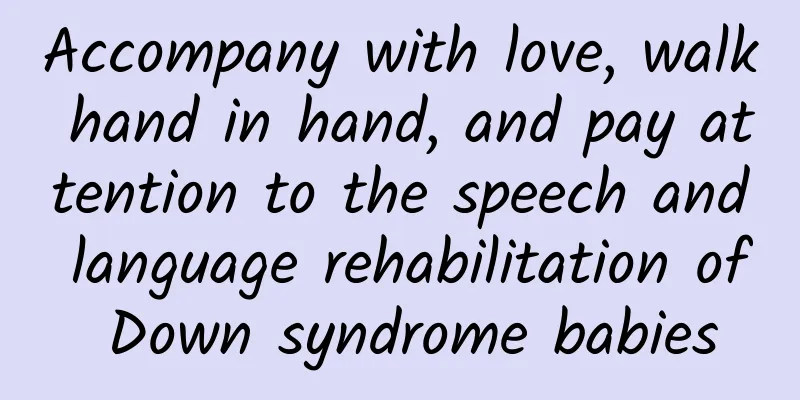Accompany with love, walk hand in hand, and pay attention to the speech and language rehabilitation of Down syndrome babies

|
March 21, 2023 is the 12th "World Down Syndrome Day". This year's theme is "With Us Not For Us", which conveys to the public the concept based on human rights that every person with Down syndrome should have the right to be treated fairly and enjoy the same opportunities as others. Down syndrome, also known as trisomy 21, is the earliest chromosomal disease identified. When a human individual has an extra chromosome 21, they will suffer from Down syndrome. It is the most common chromosomal abnormality in newborns, with an incidence of about 1/1000 worldwide. The clinical manifestations mainly include special facial features, intellectual disability, hypotonia, growth retardation, and language retardation. It is also prone to congenital heart disease, digestive tract malformations, thyroid diseases, immune system problems, and respiratory and hearing problems. Early active rehabilitation treatment can effectively promote the growth and development of "Down babies", improve their ability to take care of themselves, and improve their quality of life. In this issue of popular science, we focus on the speech and language problems of Down syndrome babies, and learn together how to provide speech and language rehabilitation training for Down syndrome babies. The language characteristics of Down syndrome babies are mainly manifested in the lack of expressive vocabulary, and there are often errors in sentence expression such as disordered word order and grammatical omissions. For example, "I want an apple" may be said as "Apple, I want". Studies have shown that the expressive ability of Down syndrome children often lags behind the development of their cognitive comprehension ability, which limits their communication ability. In addition, Down syndrome babies have varying degrees of abnormal oral movements due to low muscle tone. Drooling, tongue protrusion, unclear articulation, etc. are common manifestations of Down syndrome babies. Language skills training 01Language comprehension ability Improving language comprehension ability will help Tang Bao better understand instructions and lay the foundation for cooperating in completing various trainings in the future. So, what can we do? (1) Word comprehension training You can prepare some cards, real objects or models, such as fruits, animals, etc., show the target object/card to the children and tell them what it is, and let the children identify the target among two or more objects/cards. (2) Phrase comprehension training When the vocabulary reaches a certain level, more complex phrase training can be carried out, including subject-predicate phrases (such as "Dad goes to work"), verb-object phrases (such as "take apples"), attributive phrases (such as "red apples"), etc. Training can be carried out in the form of choosing one of two cards, performing actions according to instructions, etc. (3) Syntactic comprehension training On the basis of the above, sentence comprehension training is added. The main purpose of sentence comprehension training is to improve children's understanding and mastery of grammar and word order as a whole, including simple sentences (such as "Mom is eating"), complex sentences (such as "bei" and "ba" sentences), and other different sentence patterns. The training form is mainly to ask questions about different components in the sentence. For example, in "The little bear is taking a bath", we can help children better understand the structure of subject-verb-object sentences by asking children "Who is taking a bath?" and "What is the little bear doing?" 02Language expression ability On the basis of a certain language comprehension ability, we can train language expression ability. The specific methods are as follows: (1) Vocabulary expression training You can start with imitation, and let the child imitate and say the name of the object. After proficiency, show the object/card to the child and ask him to say the name. Be patient when training. If the child does not answer immediately after asking a question, you can wait for a few seconds and give lip shape, first sound prompts, etc. (2) Phrase expression training After becoming relatively proficient in word expression, you can practice phrase expression. During the training, more emphasis should be placed on the use of adverbs and auxiliary words in phrases, such as the use of "的" in attributive structures, such as "red apples", and "在" in prepositional phrases, such as "the apples are on the table". (3) Sentence expression training When the above training can be completed well, children can carry out sentence expression training, and can use sentence imitation, sentence connection, sentence expansion, dialogue question and answer, picture description and other forms to improve sentence expression ability. For example, when conducting sentence connection training, we can use pictures and word cards to show children the key information in the sentence, and let children connect the pictures and word cards into a complete sentence, such as "apple, brother, eat", and let children try to connect the sentence "brother eats apples" to help children master the expression of different sentence patterns. Speech articulation training The oral sensation of Down syndrome babies is relatively weak, and the oral movement is weakened to varying degrees compared to normal children due to the problem of low tension. Drooling, tongue protrusion, unclear articulation, etc. are common speech manifestations of Down syndrome babies. Therefore, the focus of Down syndrome baby speech training is to improve oral sensation and the motor ability of various articulation organs, improve articulation clarity, and improve their communication difficulties. 01Oral sensation training Use toothbrushes made of different materials, massage balls and other small tools to stimulate the inside and outside of children's mouths, improve oral and facial perception, and allow children to consciously close their lips and improve drooling. 02Oral movement training (1) Lip and cheek movements Lip and cheek movement training can not only help children pronounce the lip sounds /b/ /p//m/ clearly, but also improve drooling problems for young babies. a. Ask the child to hold the tongue depressor with his lips to resist the force of pulling it out, 10 times/group, 3 groups/day. The baby can smear the favorite jam, honey, etc. on the spoon instead of the tongue depressor. b. Purse your lips tightly, then quickly release them to produce a sound, that is, make a lip-smacking action, 10 times/set, 3 sets/day. c. Repeat the grinning and pouting movements, and combine it with pronunciation training to repeatedly say "iu", 10 times/group, 3 groups/day. (2) Tongue movement The tongue's motor ability is closely related to the clarity of articulation, so you must persist in training. a. Range of motion training: Let the child stick out his tongue forward, left, right and upward. You can use children’s favorite lollipops to induce it. Do it for 10 seconds each time, 10 times/group, and 3 groups in each direction every day. b. Resistance training: Ask the child to stretch out his tongue forward, left, right, and upward to resist with the tongue depressor, 10 times/group, 3 groups per day in each direction. c. Tongue flicking training: Taking children to play tongue flicking is not only fun, but also can improve the coordination and flexibility of the tongue. (3) Jaw training The ability to control the jaw greatly affects the pronunciation of the finals. Improving the jaw movement ability can help Down syndrome babies "close" their open mouths, and the drooling problem will naturally be improved to a certain extent. a. Resistance training: Support the child's lower jaw to provide downward resistance, and the patient resists the resistance and performs the mouth-closing movement, 10 times/set, 3 sets per day. b. Chewing training: Choose a chewing trainer of appropriate strength according to the child's condition, such as T-shaped chewing gum of different hardness for training. Do 10 times in one set, and do 3 sets on each side. (4) Soft palate training Down syndrome babies often have weak soft palate and increased nasal sounds. Soft palate training can help babies reduce nasal sounds and speak more clearly. a.Blowing training You can train through a series of blowing activities such as blowing candles, blowing bubbles, blowing small balls, blowing strips of paper, etc. Blow for 5 to 10 seconds each time, 10 times per set, 3 sets per day. b. Soft palate elevation training Say "ah" loudly, 5 to 10 seconds per time, 10 times per set, 3 sets per day. The United Nations Convention on the Rights of Persons with Disabilities calls for everyone to have the freedom to make their own choices. This year's theme is also thought-provoking. We hope that we can not only regard people with Down syndrome as objects of sympathy, and summarize and organize their lives with labels that they need to rely on others, but also accompany them with love, walk hand in hand, and light up their unique light. Here, we call on everyone to care for every person with Down syndrome, build a harmonious and inclusive society, and help them integrate into society and live a wonderful life! The popular science content of this platform has been funded by the China Association for Science and Technology's Science Popularization Department's 2022 National Science Literacy Action Project "National Society Science Popularization Capacity Improvement Project-Rehabilitation Science Popularization Service Capacity Improvement Action Plan" |
<<: How to prevent and treat rotator cuff injury
>>: Congenital muscular torticollis: early detection, early treatment
Recommend
Can a wasp sting kill a person? What should people who are allergic to bee venom do if they are stung by a bee?
Wasps are also called yellow jackets. They are th...
The reasons why the vulva sometimes itches
Vulvar itching is a very common symptom of gyneco...
Female knee weakness
When women experience back pain and general weakn...
Can I eat chocolate after induced abortion?
For our female friends, induced labor, delivery a...
Breast pain in early pregnancy
Pregnant women in the early stages of pregnancy w...
What foods are good for breast enhancement?
Everyone loves beauty. Girls like to have a slim ...
Are yeast infections in women serious?
There are many reasons that may cause women to su...
Is it torticollis that the baby likes to sleep on one side? Why do newborns like to tilt their heads?
Newborns have soft bones, so they need to be turn...
What should women eat to improve their ovaries?
Why does women's skin become so bad? As more ...
What should I do if I have cervicitis and bleeding during intercourse?
Women with cervicitis have many things to pay att...
What causes uterine effusion?
Uterine effusion is a relatively common gynecolog...
Nervous throbbing in the genitals
The female genitals are a very sensitive area, an...
Is Bai Liuli a villain in Wu Xin: The Monster Killer 3? Why did Bai Liuli turn evil?
Recently, Wu Xin: The Monster Killer 3, starring ...
Counterpoint: Global smartphone market revenue to reach approximately $410 billion in 2023, with shipments down 4%
According to the latest report released by market...
Coronary stents: a new chapter in the treatment of coronary heart disease
Coronary heart disease, as a major health challen...









